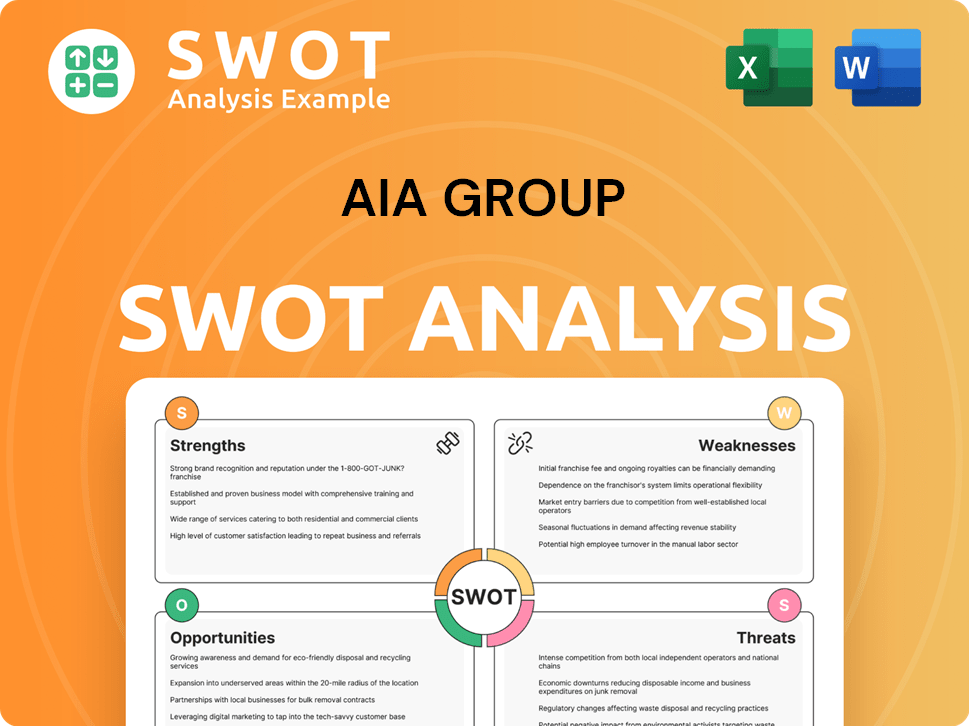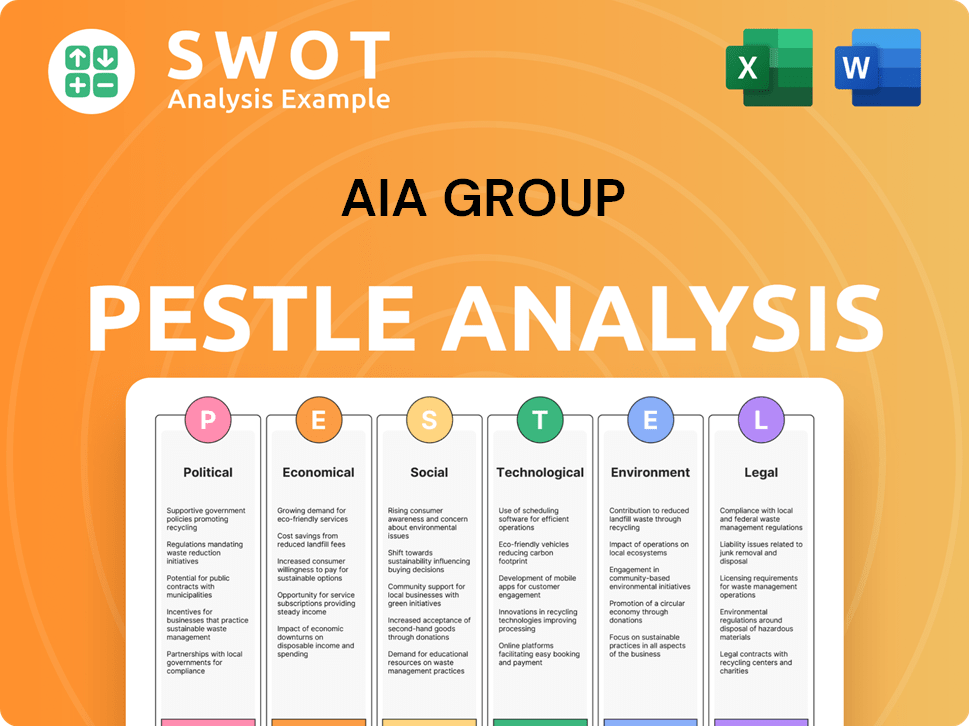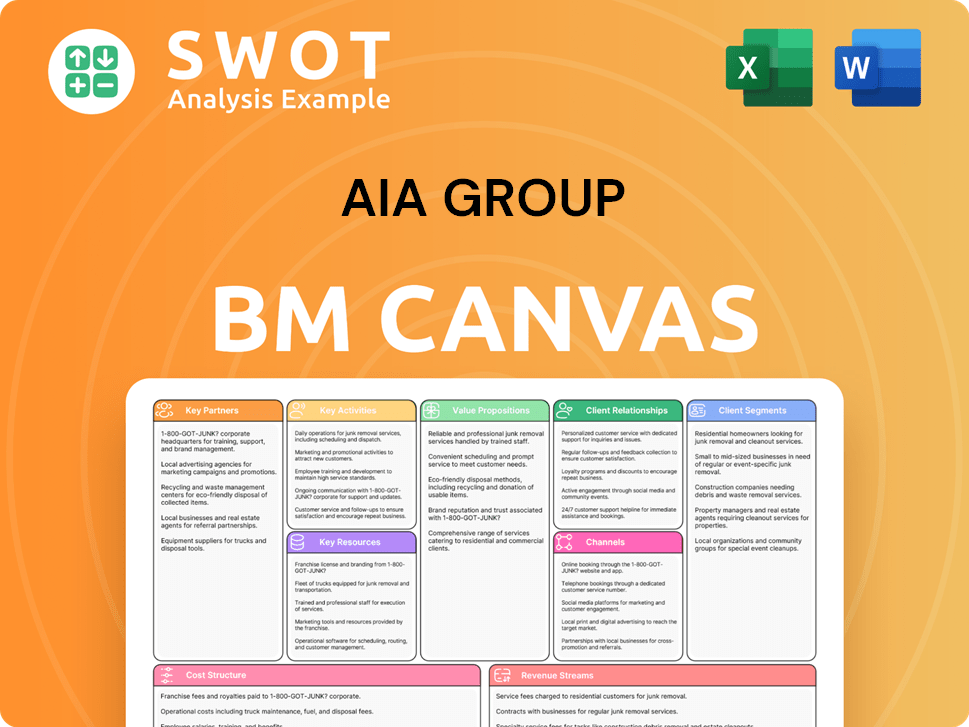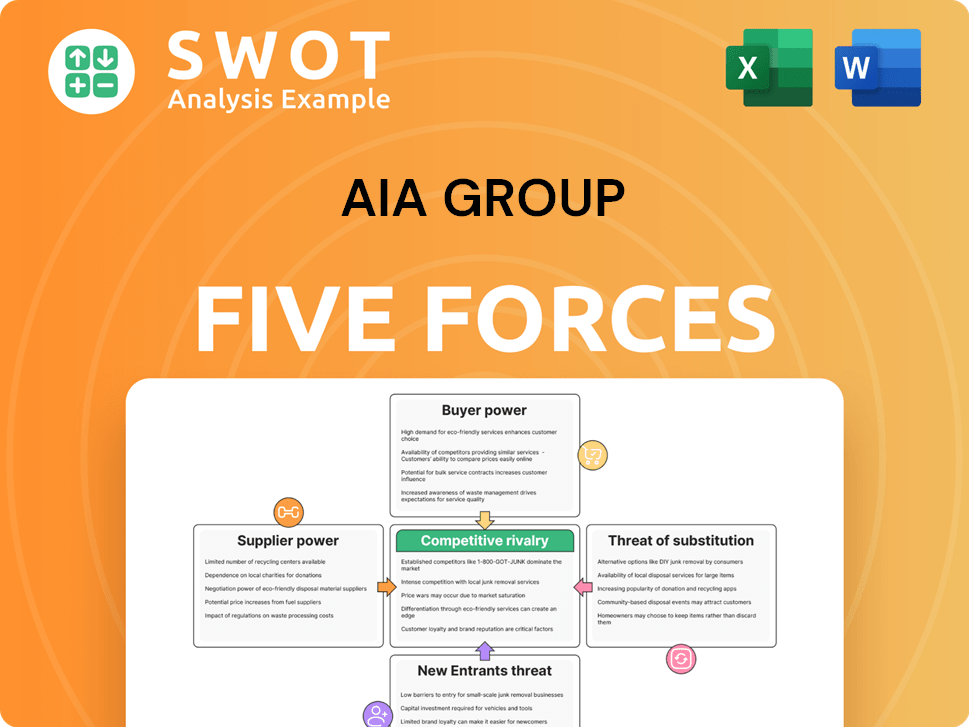AIA Group Bundle
How Does AIA Group Dominate the Asian Insurance Market?
The Asian insurance market is a battleground of financial titans, and AIA Group Limited stands as a formidable leader. Understanding the AIA Group SWOT Analysis is crucial for grasping its strategic positioning. This analysis delves into the company's competitive landscape, examining the key players and the dynamics shaping the industry.

To truly understand AIA Group's success, we must dissect its competitive environment. This includes a detailed AIA Group Market Analysis, identifying its main rivals and evaluating its strategic responses to Insurance Industry Trends. Furthermore, we'll explore AIA Group's expansion strategies in Asia and how it differentiates itself from competitors in the Financial Services Sector, providing insights into its sustained growth and market leadership.
Where Does AIA Group’ Stand in the Current Market?
AIA Group Limited has a strong market position within the Asia-Pacific insurance sector, consistently ranking among the top players. The company's primary offerings include life insurance, accident and health insurance, and savings and investment-linked plans. These products cater to a wide range of customers, from individuals and families to businesses, solidifying its presence in the financial services sector.
In 2023, AIA reported a 7% increase in Value of New Business (VONB), reaching $4,035 million. This demonstrates the company's robust performance across its diverse markets. AIA's geographic footprint spans 18 markets in the Asia-Pacific region, including wholly-owned branches and subsidiaries in key economies such as China, Hong Kong, and Thailand. This wide reach is a key part of their strategy.
AIA's strategic focus includes digital transformation to enhance customer engagement and operational efficiency. The company has invested heavily in technology to streamline processes and improve the customer experience. Financially, AIA shows strong health, with its embedded value reaching US$72.9 billion at the end of 2023, showcasing its substantial long-term value. Understanding the Target Market of AIA Group is crucial for assessing its competitive standing.
AIA Group consistently holds a leading market share in several Asia-Pacific markets. While specific 2025 figures are pending, historical data shows AIA in a top-tier position. This strong market share is a result of its broad product range and extensive geographic presence.
AIA's core products include life insurance, accident and health insurance, and savings and investment-linked plans. These offerings cater to diverse customer needs. The variety of products helps AIA maintain a competitive edge within the insurance industry trends.
AIA operates in 18 markets across the Asia-Pacific region, including key economies like China, Hong Kong, and Australia. This wide geographic reach allows AIA to diversify its risk and capitalize on growth opportunities. Expansion strategies in Asia are a key focus.
AIA is investing heavily in digital transformation to improve customer engagement and operational efficiency. This includes streamlining processes and enhancing the customer experience. These digital initiatives are crucial for staying competitive.
AIA's strong financial performance, with an embedded value of US$72.9 billion at the end of 2023, indicates its long-term value. The company's diverse product offerings and strategic geographic presence contribute to its competitive advantages. These factors allow AIA to differentiate itself from competitors.
- Strong market share in key Asia-Pacific markets.
- Diverse product portfolio catering to various customer segments.
- Extensive geographic presence across 18 markets.
- Significant investments in digital transformation.
AIA Group SWOT Analysis
- Complete SWOT Breakdown
- Fully Customizable
- Editable in Excel & Word
- Professional Formatting
- Investor-Ready Format

Who Are the Main Competitors Challenging AIA Group?
The competitive landscape for AIA Group is dynamic, shaped by a mix of global and local players vying for market share in the insurance and financial services sector. Understanding the key competitors and their strategies is crucial for assessing AIA Group's position and future prospects. The company faces challenges and opportunities in a market characterized by evolving customer needs, technological advancements, and regulatory changes.
AIA Group's ability to navigate this competitive environment is critical to its continued success. This involves analyzing the strengths and weaknesses of its rivals, adapting to industry trends, and implementing effective strategies for growth and market penetration. A thorough AIA Group market analysis is essential for informed decision-making.
The insurance industry, including AIA Group, is influenced by various factors, such as economic conditions, demographic shifts, and technological advancements. These elements impact the competitive dynamics and the strategies employed by companies to attract and retain customers. The following sections will delve into the key competitors, their strategies, and the challenges faced by AIA Group.
AIA Group's primary competitors include multinational insurers and local players. These competitors have different strengths and strategies that impact AIA Group's market position. Understanding these rivals is essential for a comprehensive AIA Group competitive landscape analysis.
Major global insurers pose significant competition to AIA Group. These companies often have extensive resources and global reach. They compete with AIA Group across various markets and product lines.
Prudential is a significant competitor, particularly in Asia, where it focuses on health and protection products. Prudential's strong presence in key Asian economies directly challenges AIA Group. Analyzing Prudential's strategies provides insights into the competitive dynamics.
Manulife is another key competitor, especially in wealth management and retirement solutions. Manulife's presence in the region impacts AIA Group's market share. Their strategies and product offerings are crucial for understanding the competitive landscape.
AXA and Allianz are major global insurers that compete with AIA Group across various markets. These companies have a broad range of insurance products and services. Their global presence and financial strength make them formidable competitors.
Local competitors, such as those in mainland China, present unique challenges. These companies often have a deep understanding of local market dynamics. They also have extensive distribution networks and strong brand recognition.
These companies are significant players in the Chinese market. Their strong domestic presence and market knowledge make them formidable competitors. They often leverage their extensive distribution networks to reach a wide customer base. As of 2024, Ping An Insurance reported a net profit of approximately CNY 85.67 billion, while China Life Insurance reported a net profit of CNY 33.82 billion, highlighting their financial strength and market dominance. These figures underscore the challenges AIA Group faces in the Chinese market.
- Market Understanding: Local competitors have a deep understanding of consumer preferences and cultural nuances.
- Distribution Networks: They often possess extensive distribution networks, including agency forces and partnerships.
- Brand Recognition: Strong brand recognition among domestic consumers gives them a competitive edge.
- Regulatory Advantage: Local companies may benefit from favorable regulatory environments.
AIA Group PESTLE Analysis
- Covers All 6 PESTLE Categories
- No Research Needed – Save Hours of Work
- Built by Experts, Trusted by Consultants
- Instant Download, Ready to Use
- 100% Editable, Fully Customizable

What Gives AIA Group a Competitive Edge Over Its Rivals?
The competitive landscape of AIA Group is shaped by its strong presence in the Asia-Pacific region and strategic initiatives. Understanding its competitive advantages is crucial for assessing its market position and future prospects. This analysis delves into AIA Group's core strengths, market strategies, and how it differentiates itself from competitors in the dynamic financial services sector.
AIA Group's success is built on a foundation of extensive market reach, brand recognition, and a robust distribution network. The company's ability to navigate diverse regulatory environments and cater to varied consumer needs across Asia-Pacific is a key differentiator. This focus, combined with continuous innovation, positions AIA Group well in the insurance industry.
AIA Group's strategic moves and competitive edge are significantly influenced by its agency model and digital transformation efforts. The company's investment in agent training and technology enhancements supports its ability to provide tailored customer service and streamline operations. These efforts are critical in maintaining and growing its market share.
AIA Group operates across 18 markets in Asia-Pacific, providing a broad geographic footprint. This extensive presence allows for risk diversification and capitalizing on regional growth opportunities. The company's deep understanding of local markets is a significant advantage in the Brief History of AIA Group.
AIA Group benefits from strong brand recognition and customer trust, cultivated over a century. This brand strength supports customer loyalty, which is crucial in the insurance industry. Customer trust is a key factor in driving sales and maintaining market share.
AIA Group's agency model is a key differentiator, with heavy investment in agent training and development. This direct distribution channel provides a competitive edge over rivals. The focus on a professional sales force enhances customer service and product recommendations.
AIA Group is proactive in its digital transformation, leveraging technology to improve customer experience and streamline operations. This includes enhancing data analytics for better risk assessment and product development. Digital initiatives are crucial for staying competitive in the financial services sector.
AIA Group's competitive advantages include its extensive pan-Asian presence, robust brand equity, and a productive agency force. Its long-standing history and deep market penetration across 18 markets in Asia-Pacific provide an unparalleled understanding of diverse consumer needs and regulatory environments. The company's scale allows for economies of scale in operations, underwriting, and investment management, contributing to cost efficiencies and competitive pricing.
- Extensive Market Reach: Operating across 18 markets in Asia-Pacific, providing broad geographic diversification.
- Strong Brand Recognition: Cultivating customer trust and loyalty through a century of operations.
- Proprietary Agency Model: Investing in agent training, leading to a professional and productive sales force.
- Digital Transformation: Enhancing customer experience and streamlining operations through technology.
AIA Group Business Model Canvas
- Complete 9-Block Business Model Canvas
- Effortlessly Communicate Your Business Strategy
- Investor-Ready BMC Format
- 100% Editable and Customizable
- Clear and Structured Layout

What Industry Trends Are Reshaping AIA Group’s Competitive Landscape?
The competitive landscape for AIA Group is significantly influenced by industry trends, regulatory changes, and evolving consumer preferences. The company faces both challenges and opportunities in a dynamic market, requiring strategic adaptation to maintain and enhance its position. Understanding the Growth Strategy of AIA Group is crucial for assessing its future prospects.
The Asia-Pacific insurance market, where AIA operates, is experiencing rapid digitalization, with technological advancements impacting product development and customer engagement. Regulatory changes and shifts in consumer preferences towards health and wellness also play a key role. AIA's ability to navigate these factors will determine its success in the coming years.
Digitalization is transforming the insurance sector, with AI, big data, and blockchain reshaping operations. Regulatory changes, particularly in China, are constantly impacting business models. Consumer demand is shifting towards personalized, health-focused, and digitally accessible insurance solutions.
Continuous investment in technology is essential to stay competitive. Stricter data privacy regulations require careful adaptation. Managing the rising expectations of digitally-savvy customers is a key challenge. Insurtech entrants and established players with strong digital capabilities pose competitive threats.
Emerging markets in Asia offer significant growth potential due to low insurance penetration. There is increasing demand for health and wellness solutions. Strategic partnerships with technology companies can enhance digital offerings. Capitalizing on these opportunities is vital for AIA's growth.
AIA is focusing on digital transformation, product innovation in health and protection, and strengthening its agency force. These strategies aim to capitalize on opportunities and maintain a strong competitive position. The company's adaptability is key to its long-term success.
AIA Group's competitive advantages include its strong brand recognition, extensive distribution network, and focus on health and wellness products. The company's financial performance, as of 2024, reflects its resilience in the face of market challenges. AIA's market share analysis in 2024 shows its continued dominance in key Asian markets.
- Digital Transformation: Implementing advanced technologies to improve customer experience.
- Product Innovation: Developing health and protection products tailored to consumer needs.
- Strategic Partnerships: Collaborating with tech companies to enhance digital capabilities.
- Market Expansion: Targeting high-growth markets with low insurance penetration.
AIA Group Porter's Five Forces Analysis
- Covers All 5 Competitive Forces in Detail
- Structured for Consultants, Students, and Founders
- 100% Editable in Microsoft Word & Excel
- Instant Digital Download – Use Immediately
- Compatible with Mac & PC – Fully Unlocked

Related Blogs
- What are Mission Vision & Core Values of AIA Group Company?
- What is Growth Strategy and Future Prospects of AIA Group Company?
- How Does AIA Group Company Work?
- What is Sales and Marketing Strategy of AIA Group Company?
- What is Brief History of AIA Group Company?
- Who Owns AIA Group Company?
- What is Customer Demographics and Target Market of AIA Group Company?
Disclaimer
All information, articles, and product details provided on this website are for general informational and educational purposes only. We do not claim any ownership over, nor do we intend to infringe upon, any trademarks, copyrights, logos, brand names, or other intellectual property mentioned or depicted on this site. Such intellectual property remains the property of its respective owners, and any references here are made solely for identification or informational purposes, without implying any affiliation, endorsement, or partnership.
We make no representations or warranties, express or implied, regarding the accuracy, completeness, or suitability of any content or products presented. Nothing on this website should be construed as legal, tax, investment, financial, medical, or other professional advice. In addition, no part of this site—including articles or product references—constitutes a solicitation, recommendation, endorsement, advertisement, or offer to buy or sell any securities, franchises, or other financial instruments, particularly in jurisdictions where such activity would be unlawful.
All content is of a general nature and may not address the specific circumstances of any individual or entity. It is not a substitute for professional advice or services. Any actions you take based on the information provided here are strictly at your own risk. You accept full responsibility for any decisions or outcomes arising from your use of this website and agree to release us from any liability in connection with your use of, or reliance upon, the content or products found herein.